Things seem to be changing rapidly now in Bermondsey but the Vitrine was the first contemporary art gallery in the area; can you tell us the difference this has made for you and your exhibitions and projects?
It's great that people feel Vitrine has had such a part to play in the growth of the area. I'm always flattered by this. There has been an art scene in Bermondsey for some years, but the recent change in the area and the focus on it now have been rapid and is very exciting to be a part of this. The growth of Vitrine concurrent to this has been equally quick and the two things really feel like they have fed into each other. Back in early 2010, when we started Vitrine on Bermondsey Square, most people had no idea where it was. We created a programme of events that included exhibition openings, performance and screenings, and there was always a good party (as you know!). From this, we quickly built our audience and with more and more small businesses and arts spaces developing in the area we all fed off each other.
Then White Cube arrived and this has obviously had a big effect on a young gallery like Vitrine. They have been a supportive and approachable neighbour gallery (perhaps surprisingly so!). They bring a huge audience to Bermondsey Street and have totally raised the bar for commercial gallery spaces, which is amazing to see. Take, for example, Frieze; we launched our Bermondsey Street space last year and our newly expanded premises this year during Frieze. We had a huge number of international visitors. Many from our growing client-base were encouraged to make time for a visit to the area and as an art crowd over for the fair who mainly don't leave London’s centre, they were curious to get down to Bermondsey. This obviously has a major impact on a young, growing gallery.
This also affects regular programme; our openings are often on the same night as White Cube and we also do a double Vitrine opening across both our spaces so we get a good crowd – a bit like Vyner Street once was, back in the day.
I was brought up in South East London and so have been around to hear people saying it would take the art spotlight one day. It's great to be here now I think it finally is!
You have always taken advantage of the space and areas around the gallery, incorporating the square and cinema into your programme; is this still part of your ethos, do you hope to continue with this aspect and what do you have coming up?
Definitely. I approach curating and programming in the same way I previously approached my practice as an artist. I am interested in a multidisciplinary practice in a multiplatform space and hopefully therefore ambitious ideas around the combination of this. I have curated Bermondsey Square exhibitions for four years now and last year I curated thirteen shows across the two spaces, so I decided to start to invite others to contribute to the programme. I am programming different artists and curators to curate exhibitions and many of these are equally drawn to the space because of the potential of the square, cinema and entire development, as well as the unusual and unique exhibition space. In January,we have The Ister, a collective from Brussels. I was drawn to them as they are doing exciting things as a group of curator/artist/writers who programme exhibitions and events in varied locations with some great outcomes.
I have also taken on a basement space at 183-185 Bermondsey Street, where we are thinking around ideas of talks, performances and other activities. Leah Capaldi already has her eye on this space for a performance as an extension of her show with Stéphanie Saadé, opening in January.
The original Vitrine gallery was unusual in that it was all window with no internal space.You now have a more conventional, ground-floor space; has this changed your programming?
I actually find it more of a challenge to work with such a conventional space and try to rethink it through curation. It's important for me that the two spaces coexist with their own very distinct programme and goals. I've been analysing my curatorial practice and programming approach so as to better understand where to carry this.
I think as well as the site-responsive aspect of my previous work, I always think of shows as both exhibition and installation. The artists I work with have this inherent in their practices so it is something that threads through the solo and group shows we present. I often refer back to the Exposition Internationale du Surréalisme and to Hans-Ulrich Obrist's early curatorial projects and writing. One of my favourite Serpentine shows was Philippe Parreno's, which was perhaps the most successful video exhibition/installation I've seen. It gripped the space and the viewer within the work.
Our January show with Leah Capaldi brings video into Vitrine. We are presenting a series of works that also exist as installation. Similarly,Stéphanie Saadé, who is exhibiting with her in this two-person, will present a body of work and an installation. I have wanted to bring these two artists work together for some time and we have been discussing the show for months via Skype and email, but with a show like this it will be the install when the whole thing comes together. It has raised really exciting questions about how to present a two-person show that involves two installations and a body of work. The dialogue that this is creating between the artists and myself will be inherent and hopefully visible in the show itself.
The programming at Vitrine is very much about this type of ongoing dialogue I have with the artists I work with. John Walter said to me recently that he believes that for all artists ‘your perfect gallery doesn't exist yet’, because we are all part of its creation. Vitrine artists embrace the different spaces and the variation in this so I guess we'll see what the newer Bermondsey Street space brings in due course.
On 29 November you opened a solo exhibition by Mia Goyette, curated by Katherine Gardner. Can you tell us a bit a about your decision to use guest curators?
As I mentioned, it will be four years in March since Vitrine Bermondsey Square opened and apart from inviting one or two outside curators per year to curate shows, I have been curating it. I felt it was time to get more and new perspectives on this space. It's tough to pull myself away from it as I always have new ideas for it and an enormous number of thought-provoking proposals for it. Last year I curated a ridiculous number of shows across the two spaces, and externally, so there is also this factor. I think 2014 is the year for me to focus on the Bermondsey Street gallery and programme new invited curators for Bermondsey Square. It's exciting for me to see these new people becoming involved.
Can you tell us a bit about the Leah Capaldi & Stéphanie Saadé two-person exhibition you have got coming up? Why do you think the artwork or methodology of these artists works together?
I met and worked with a Lebanese curator, Amanda Abi Khalil, last year. She introduced me to Stéphanie's work and we immediately saw parallels with Leah's practice. When I first entered a conversation with Leah about a show at the Bermondsey Street space, I suggested a two or three-person as it's something she hasn't done and I thought would raise interesting questions around the process of exhibition-making, which is ingrained in Leah's work itself. Following her show at Invites, 176 Zabludowicz last year and lots of group shows, I was interested in how Leah would approach a two person. We started talking to a number of artists including Stéphanie, whose work I have always been drawn to and brought about some really great conversations and possibilities.
Both artists explore the performativity of objects and display and they will use the gallery space as a platform to question the role of the individual, as ‘the watcher’ and ‘the watched’, and the object, as ‘prop’ and ‘sculpture’. Leah and Stéphanie present the viewer with conditions of display and pose enquiries into the act of encountering object, body, performer, artist or artwork. The exhibition experience itself is brought into question and manipulated inquisitively. It's an ambitious and exciting exhibition to work on.
What do you have planned for the future, both in the gallery and elsewhere?
We have solo exhibitions with Will Murray and Edwin Burdis in the spring at Bermondsey Street. I've been developing these for some time with both artists; the work is well underway. I'm also working on a potential large-scale project for Bemondsey Square (currently top secret!) and I'm off to the US again this December, which keeps drawing me back, so that's another space to watch!
Adrian Lee
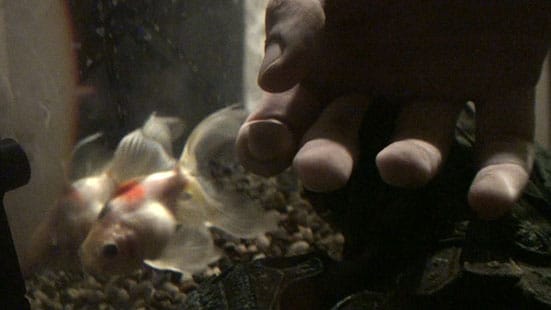
Leah Capaldi
Untitled
2013
Video still
Image courtesy of VITRINE.
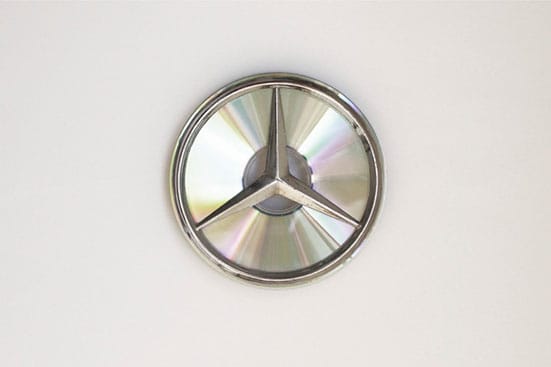
Stéphanie Saadé
Re-Enactment LB/ Taxi
2013
CD, Mercedes Sign
Diameter 12 cm
Image courtesy of VITRINE.
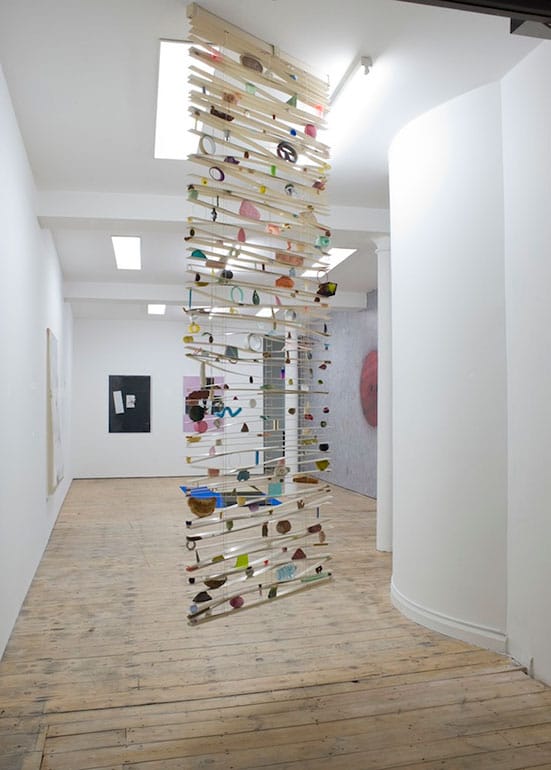
Samara Scott
Dreamcatcher
2012
Venetian blind and mixed media
Dimensions variable
Installation shot, VITRINE Bermondsey Street.
Image courtesy of VITRINE.
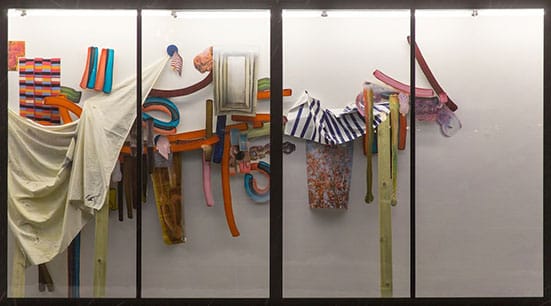
Wil Murray
Painted Shut
2013
Mixed media Installation
Dimensions variable
Installation shot, VITRINE Bermondsey Square
Image courtesy of VITRINE.
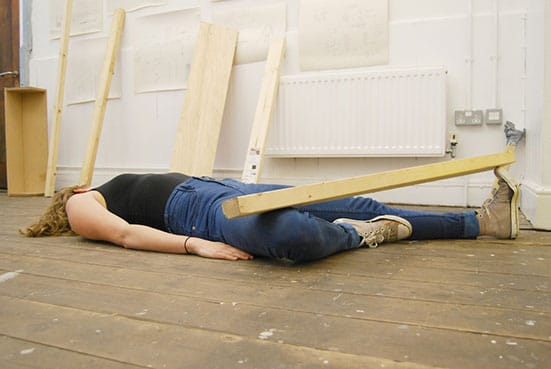
Leah Capaldi
Study for 2 x 3
2012
Performance, 1 hour 6 Times Daily
Image courtesy of The Zabludowicz Collection.